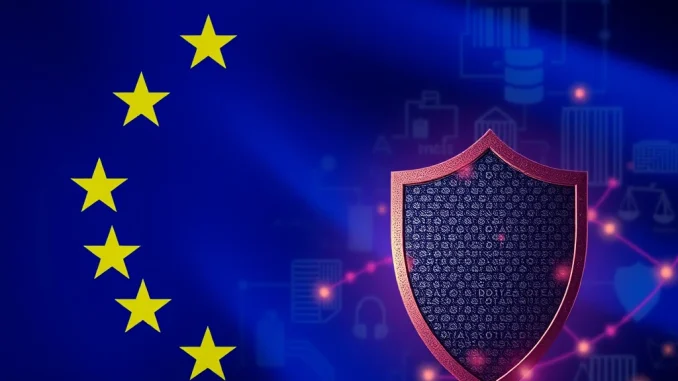
Attention cryptocurrency and blockchain enthusiasts! A crucial development is unfolding in Europe that could significantly impact how blockchain technology intersects with privacy rights. The EU’s primary data protection authority is stepping in, seeking public input on how to handle personal data blockchain interactions within the strict framework of GDPR. This is a pivotal moment for the industry, highlighting the ongoing effort to balance innovation with fundamental data privacy principles.
Understanding the EDPB’s Initiative on EU Blockchain Data Rules
The European Data Protection Board (EDPB) serves as the EU’s independent body responsible for ensuring the consistent application of the General Data Protection Regulation (GDPR) across the European Economic Area. Think of them as the ultimate referees for data privacy in Europe. Recently, the EDPB approved draft guidelines specifically addressing the complex landscape of using personal data on blockchain networks. This move, as reported by Decrypt, signals a clear intent to provide much-needed clarity and guidance for blockchain developers, businesses, and users operating within or interacting with the EU.
The core of these proposed EU blockchain data rules is to navigate the inherent characteristics of blockchain technology – like its distributed ledger, immutability, and often pseudo-anonymous nature – against the rights and obligations mandated by GDPR. It’s a technical and legal tightrope walk.
Why is Navigating GDPR Blockchain Compliance So Challenging?
At first glance, blockchain and GDPR seem fundamentally at odds. GDPR grants individuals rights over their personal data, including the right to access, rectification, and crucially, the ‘right to erasure’ (the right to be forgotten). It also requires identifying clear data controllers and processors responsible for data handling.
However, blockchain’s design presents unique hurdles:
- Immutability: Data written to a blockchain is typically permanent and cannot be altered or deleted. This directly conflicts with the right to erasure.
- Decentralization: Identifying a single data controller or even multiple controllers/processors can be incredibly difficult in a distributed network where data is spread across numerous nodes globally. Who is responsible when there’s no central authority?
- Transparency vs. Pseudonymity: While addresses are pseudonymous, transactions are public. Sophisticated analysis can sometimes de-anonymize data, turning pseudo-anonymous data into identifiable personal data, which then falls under GDPR.
- Global Nature: Blockchain networks operate across borders, complicating jurisdiction and enforcement of regional regulations like GDPR.
These characteristics make achieving full GDPR blockchain compliance a significant technical and legal puzzle.
Key Principles Highlighted in the Draft EDPB Blockchain Guidelines
The EDPB’s draft aims to provide a framework for addressing these challenges. While the full details are in the draft document itself, the core emphasis, according to reports, is on proactive measures:
The guidelines stress the importance of:
- Data Protection by Design and Default: Incorporating privacy considerations into the very architecture and development of blockchain solutions from the outset, not as an afterthought.
- Identifying Roles and Responsibilities: Providing guidance on how to determine who qualifies as a data controller or processor within different blockchain setups (e.g., public, private, consortium).
- Implementing Appropriate Safeguards: Recommending technical and organizational measures to protect personal data, even within the constraints of blockchain technology. This might involve using off-chain storage for sensitive data, employing zero-knowledge proofs, or carefully considering what type of data is stored on-chain.
- Lawful Basis for Processing: Ensuring there is a valid legal ground under GDPR for processing any personal data on the blockchain.
These principles underscore that simply using blockchain doesn’t exempt projects from their data protection obligations.
What This Means for the Use of Personal Data Blockchain Solutions
For developers and companies building blockchain applications that handle any form of identifiable information – whether it’s KYC data, transaction history linked to individuals, or any other form of personal data blockchain-related – these guidelines are essential reading. They signal that regulators expect due diligence and a proactive approach to privacy.
It means projects must carefully evaluate:
- Whether storing personal data on-chain is truly necessary.
- Alternative technical solutions if on-chain storage is unavoidable (e.g., encryption with off-chain keys, storing only hashes).
- How they will respond to data subject requests, particularly the right to erasure, given immutability.
- Who is accountable for data protection within their specific blockchain implementation.
Ignoring these considerations could lead to significant legal and financial penalties under GDPR.
Your Opportunity to Shape Blockchain Data Protection
Crucially, the EDPB is actively seeking input from the public and industry stakeholders on these draft EDPB blockchain guidelines. The comment period is open until June 9th. This is a vital opportunity for the blockchain community – developers, businesses, legal experts, and privacy advocates – to provide feedback, highlight practical challenges, and help shape the final version of these rules. Constructive input can help ensure the guidelines are both effective in protecting data and practical for the technology’s continued development.
Conclusion: Towards Responsible Blockchain Data Protection
The EDPB’s draft guidelines represent a significant step towards establishing a clearer regulatory path for using blockchain technology in a manner compliant with robust data protection laws like GDPR. While challenges remain, the emphasis on ‘data protection by design’ and identifying responsibilities provides a necessary framework. Engaging with the public comment period is key for the industry to contribute to rules that foster responsible innovation and ensure effective blockchain data protection for individuals in the digital age. This ongoing dialogue is essential for the healthy growth of blockchain technology within the EU and serves as a potential model for other jurisdictions grappling with similar questions.



